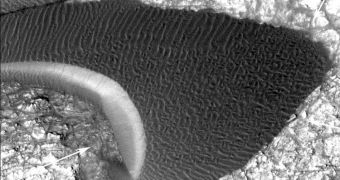Mission controllers at the NASA Jet Propulsion Laboratory say that the Mars Reconnaissance Orbiter has revealed surprising dune motion patterns on the Red Planet. Sand masses were found to move in similar patterns to those on Earth, even though the atmospheres surrounding the two planets are very different from one another.
A series of images, taken 3 years apart, reveals dunes that have been pushed back by a significant margin. What makes this discovery so interesting is the fact that the Martian atmosphere is just one percent the density of Earth's, and high-speed winds are much rarer.
These winds are the primary drivers of dune motions on our planet, so the new discovery suggests that dunes can be moved from their initial locations through other mechanisms as well. The main implication of the new MRO study is that the Martian landscape is still active.
Until recently, investigators were convinced that the landscape features they were seeing on Mars were relics of a bygone era, when the planet had conditions more suitable for life, and liquid water on the surface. The new data indicate that our neighboring world is active even now.
The sand movements were observed in photographs produced by the High Resolution Imaging Science Experiment (HiRISE) camera aboard the spacecraft. MRO entered orbit around Mars in March 2006.
A careful analysis of these images has revealed that 200-foot (61-meter) thick sand dunes are moving coherently across the landscape. Experts published details of their investigation in the May 9 issue of the top scientific journal Nature.
“This exciting discovery will inform scientists trying to better understand the changing surface conditions of Mars on a more global scale,” explains the director of the Mars Exploration Program at NASA Headquarters, Doug McCuistion.
“This improved understanding of surface dynamics will provide vital information in planning future robotic and human Mars exploration missions,” the official goes on to say. The HiRISE images were snapped in 2007 and 2010.
“We chose [the Nili Patera region] because we knew there was sand motion going on there, and we could quantify it,” Johns Hopkins University Applied Physics Laboratory planetary scientist Nathan Bridges explains. He was the lead author of the new paper.
“The Nili dunes also are similar to dunes in places like Antarctica and to other locations on Mars,” he concludes.

 14 DAY TRIAL //
14 DAY TRIAL //